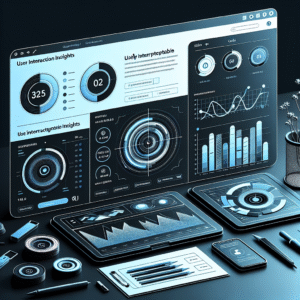
Enhancing User Experience: The Best WordPress Heatmap Plugins to Track User Behavior
Understanding Heatmaps
Discover the power of heatmaps in enhancing user experience and maximizing website efficiency. Learn how to integrate these tools for a data-driven approach to site optimization.
Heatmaps are visual representations of data that help website owners understand user interaction on their sites. By utilizing color gradients, these tools illustrate what elements on a webpage attract the most attention, are clicked the most, and where user engagement tends to drop off. This serves as a crucial aspect of refining user experience and enhancing website efficiency.
When a heatmap highlights a page section that garners high activity, this could indicate effective placement of content or call-to-action elements. Alternatively, areas with little engagement might need improvement, such as modifying the content or altering its positioning. Such insights allow website owners to make data-driven decisions that improve overall user engagement and satisfaction.
In the context of WordPress sites, integrating a WordPress heatmap plugin can be incredibly beneficial. These plugins seamlessly add heatmap functionality to your site without requiring manual coding, thus allowing you to track user behavior efficiently. A heatmap, coupled with features from a track user behavior WordPress plugin, provides a comprehensive look into user navigation patterns.
Key Benefits of Using Heatmaps
-
Enhance user experience by visualizing user interaction patterns.
-
Identify high and low engagement areas for targeted improvements.
-
Boost conversion rates through informed content strategy.
Top Features to Look For
Real-Time Tracking
Monitor visitor interactions as they happen, offering immediate insights for time-sensitive campaigns.
Comprehensive Heatmaps
Gain detailed visualizations of user interaction with tools like scroll maps and click maps.
Session Recording and Replay
Watch actual visitor journeys to enhance user experience and increase conversion rates.
Mobile Responsiveness
Track mobile sessions accurately, providing the same quality insights as desktop analytics.
Integration and Compatibility
Ensure seamless integration with current systems and compatibility with popular WordPress tools.
Automated Reporting
Generate automatic reports to consistently provide up-to-date visitor behavior insights.
Privacy Concerns Addressed
In the digital age, privacy concerns have become a critical consideration for users, especially when it comes to installing plugins that track behavior, such as WordPress heatmaps. While these tools provide valuable insights into how visitors interact with your website, ensuring user data is kept confidential is paramount. Therefore, opting for privacy-focused WordPress heatmap plugins is crucial in alleviating these concerns.
Anonymized Data Collection
These plugins anonymize user data, ensuring that no personally identifiable information is tracked or stored. This approach emphasizes data protection and user confidentiality.
- Complies with GDPR regulations
- Offers transparency in data usage
Local Data Storage
By storing data locally on your server, these plugins minimize the risk of unauthorized access and prevent the sharing of sensitive data with third-party services.
- Enhances control over data management
- Customizable data retention policies
Top WordPress Heatmap Plugins
Crazy Egg
Robust solution with click maps, scroll maps, and visual recordings. Offers A/B testing and emphasizes visitor data protection.
Learn MoreHotjar
Combine heatmaps with session recordings. Offers a free tier and is GDPR-compliant with anonymization options.
Learn MoreMouseflow
Provides multiple types of heatmaps with session replay. Renowned for its compliance with privacy laws.
Learn MoreWP Hotjar
Seamless integration providing extensive features, often a cost-effective solution with customization options.
Learn MoreLucky Orange
Features heatmaps, visitor recordings, and live chat capabilities with strong user protection features.
Learn MoreInstallation and Setup Guide
1. Choose Your Plugin
Select a reliable heatmap plugin from the WordPress repository. Options like “Crazy Egg,” “Hotjar,” or “Mouseflow” are ideal. Ensure compatibility with your WordPress version and that it meets your needs in showcasing user clicks.
2. Install the Plugin
Navigate to your WordPress dashboard. Click “Plugins,” then “Add New.” Search for your plugin and click “Install Now.” Activate it right after installation.
3. Configure the Plugin
After installation, configure settings to fit your needs. Set up accounts if needed, customize tracking, and utilize filters for better segmenting of data.
4. Test the Implementation
Visit your web pages to ensure the plugin captures interactions correctly. Refresh your dashboard to verify data flow.
5. Adjust Settings as Needed
Analyze your heatmap data for insights. Adjust your settings for improved tracking and focus on crucial areas.
Interpreting the Data
Interpreting heatmap data is essential for understanding user interaction on your WordPress site. By properly analyzing this data, you can significantly enhance your site’s performance and user experience.
Identifying Patterns
Focus on trends and patterns rather than isolated actions. Concentrated clicks on non-clickable elements could indicate poor design, while low interaction with CTAs might suggest they need more prominence.
Learn MoreAnalyzing Key Pages
Start with your homepage or landing pages. Determine which sections attract the most attention. Adjust content layout and prioritization based on these insights for better engagement.
Get in TouchUnderstanding Scrolling Behavior
If users stop scrolling at certain points, it may indicate unengaging content or slow load times. Use these insights to improve engagement and keep visitors longer.
Explore PluginsUtilize a track user behavior WordPress plugin for automated data collection, allowing you to focus on interpreting insights to refine your site’s design and boost conversions.
Using Heatmaps to Improve Conversions
Discover how decoding visitor interactions through heatmaps can unlock new levels of conversion and engagement for your site.
Gain Insights
Leverage heatmaps to visualize where users click, scroll, and spend time. Analyze this data to enhance user experience and improve your site’s effectiveness.
Actionable Changes
Relocate cold CTA buttons to hot zones and optimize content placement by focusing on high-engagement areas. A strategic shift for boosting conversion rates.
Get StartedOptimize Design
Use heatmap data to streamline your site’s design. Remove distractions, enhance focus, and create a user-friendly interface to encourage conversions.
Combine with Plugins
Integrate top conversion plugins with heatmap insights to amplify your site’s performance. Set the stage for a conversion-optimized future.
The Future of Heatmap Plugins
Explore upcoming trends and innovations in heatmap plugins, and stay informed to prepare for future updates.
1. AI-Driven Analytics
Artificial Intelligence is set to transform heatmap plugins by automating the process of analyzing user interactions and predicting behaviors.
Imagine a system that learns from your visitors and adapts your website layout automatically to improve engagement.
2. Enhanced User Segmentation
Future plugins will offer more sophisticated user segmentation, ensuring valuable insights without compromising user privacy.
Tailored experiences based on user segments can drastically improve overall satisfaction.
3. Seamless Integration
Future heatmap plugins will sync effortlessly with existing tools, creating comprehensive data ecosystems for better analytics.
4. Predictive Analysis
With predictive analytics, be proactive in preparing sites for user behavior changes before they occur.
5. Mobile-First Design Analysis
As mobile browsing dominates, future heatmap plugins will ensure optimizations cater to mobile-specific interactions.
Browse Categories:
You may also like

Mastering User Engagement: Top WordPress Plugins for Tracking and Interaction
Explore top WordPress plugins for tracking and enhancing user interaction, optimizing your site's engagement strategy.

Choosing Right: Top Plugins to Track and Enhance User Interactions on WordPress
Discover top WordPress plugins to track and improve user interactions, enhance UX, and boost conversions, ensuring optimal performance.

Enhance User Experience with WordPress Click Tracking and Heatmap Plugins
Unlock user insights with top WordPress click tracking and heatmap plugins to boost engagement and conversion rates.